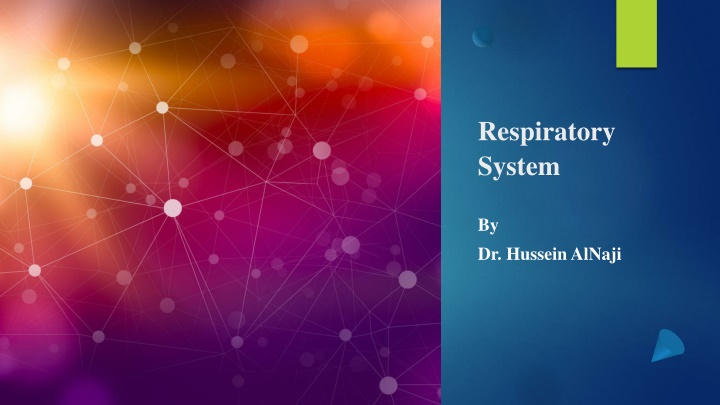
Respiratory Insufficiency and Hypoxia in Human Physiology
Explore the principles of respiratory insufficiency and different types of hypoxia in the human body. Learn how inadequate oxygenation affects various organ systems and diseases, as well as the mechanisms behind different forms of hypoxia. Discover the roles of the respiratory system in gas exchange, thermoregulation, acid-base balance, metabolism, and immune response.
Download Presentation

Please find below an Image/Link to download the presentation.
The content on the website is provided AS IS for your information and personal use only. It may not be sold, licensed, or shared on other websites without obtaining consent from the author. If you encounter any issues during the download, it is possible that the publisher has removed the file from their server.
You are allowed to download the files provided on this website for personal or commercial use, subject to the condition that they are used lawfully. All files are the property of their respective owners.
The content on the website is provided AS IS for your information and personal use only. It may not be sold, licensed, or shared on other websites without obtaining consent from the author.
E N D
Presentation Transcript
Respiratory System By Dr. Hussein AlNaji
Principles of Respiratory Insufficiency 2 The principal function of the respiratory system: 1- Gas exchange in which oxygen is transferred from the environment to the blood and carbon dioxide is moved in the opposite direction. 2- Arole in thermoregulation in most species. 3- In acid-base regulation in concert with the kidney 4- In functioning as an endocrine organ (e.g., angiotensin converting enzyme). 5- In the metabolism of metabolically active substances including eicosanoids and nitric oxide. 6- In the immune response to inhaled immunogens and pathogens.
3 HYPOXIA Failure of the tissues to receive an adequate supply of oxygen. Occurs in a number of ways, and the differences are clinically relevant because they are associated with failure of different organ systems and different diseases, and they have fundamentally different pathophysiologic mechanisms
a. Hypoxic (or Hypoxemic) Hypoxia Hypoxic (or hypoxemic) hypoxia Occurs when there is inadequate oxygenation of blood (hypoxemia) and is usually associated with disease of the respiratory tract or other causes of hypoventilation. Situations in which there is inadequate oxygenation of blood in the lungs include hypoventilation, ventilation-perfusion mismatches, diffusion impairment, low inspired oxygen tension, and extrapulmonary right-to-left shunting.
5 b- Anemic Hypoxia Anemic hypoxia occurs when there is a deficiency of hemoglobin per unit volume of blood (anemia). The percentage saturation of the available hemoglobin and the oxygen tension of arterial blood are normal but as a result of the low hemoglobin concentration the oxygen-carrying capacity of the blood is reduced. 1- Anemia resulting from any cause has these characteristics. 2- Alteration of hemoglobin to pigments, such as in poisoning caused by nitrite converted hemoglobin to methemoglobin or carboxyhemoglobin du to poising with carbon monoxide, that are not capable of carrying oxygen has the same effect on oxygen content as anemia.
6 c- Circulatory Hypoxia Circulatory hypoxia occurs as a result of inadequate delivery of oxygen to tissue because of inadequate perfusion of tissues by blood. A common cause of this is low cardiac output, 1- congestive heart failure or hypovolemic shock. 2- local interruption to arterial flow, such as the thrombotic emboli of thromboembolic colic of horses 3- compression of vessels, such as in right displacement and torsion of the abomasum
d- Histotoxic Anoxia 7 Histotoxic anoxia occurs when oxygen delivery to tissue is adequate because both oxygen content of arterial blood and blood flow are appropriate, but the tissue is unable to utilize oxygen. Cyanide poisoning is the only common cause of this form of anoxia. Consequences of Hypoxia Consequences of inadequate delivery of oxygen include changes in almost all body systems. The central nervous system and heart are most susceptible to the immediate and acute effects of hypoxia, whereas clinical signs related to hypoxic damage to the gastrointestinal tract and kidneys are somewhat delayed.
CARBON DIOXIDE RETENTION (HYPERCAPNIA) 8 Respiratory insufficiency results in decreased elimination of carbon dioxide and its accumulation in blood and tissues. Acute hypercapnia causes a respiratory acidosis that reduces both blood and cerebrospinal fluid pH. The clinical signs of acute hypercapnia are initial anxiety followed by central nervous system depression and eventual coma and death. Respiratory failure It is the terminal stage of Respiratory insufficiency in which the activity of the respiratory centers diminishes to the point where movements of respiratory muscles cease. Respiratory failure can be paralytic, dyspneic or asphyxial, or tachypneic, depending on the primary disease.
Principal Manifestations of Respiratory Insufficiency The common signs of respiratory disease are as follows: 1- Abnormalities in the rate, depth, or ease of breathing 2- Lethargy or exercise intolerance. 3- Abnormal posture. 4- Abnormal lung sounds. 5- Abnormal respiratory noises. 6- Coughing. 7- Cyanosis. 8- Nasal discharge. 9- Epistaxis and hemoptysis. 9
10 Thank You
